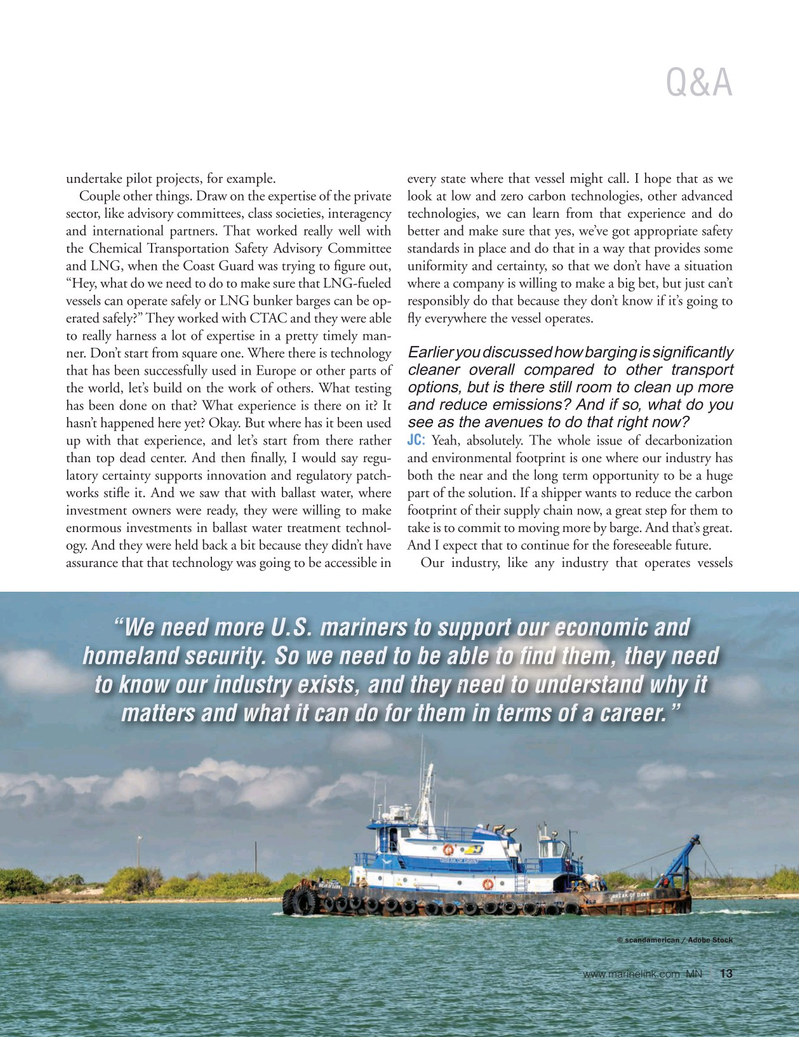
Page 13: of Marine News Magazine (March 2022)
Pushboats, Tugs & Barges
Read this page in Pdf, Flash or Html5 edition of March 2022 Marine News Magazine
Q&A undertake pilot projects, for example. every state where that vessel might call. I hope that as we
Couple other things. Draw on the expertise of the private look at low and zero carbon technologies, other advanced sector, like advisory committees, class societies, interagency technologies, we can learn from that experience and do and international partners. That worked really well with better and make sure that yes, we’ve got appropriate safety the Chemical Transportation Safety Advisory Committee standards in place and do that in a way that provides some and LNG, when the Coast Guard was trying to ? gure out, uniformity and certainty, so that we don’t have a situation “Hey, what do we need to do to make sure that LNG-fueled where a company is willing to make a big bet, but just can’t vessels can operate safely or LNG bunker barges can be op- responsibly do that because they don’t know if it’s going to erated safely?” They worked with CTAC and they were able ? y everywhere the vessel operates.
to really harness a lot of expertise in a pretty timely man-
Earlier you discussed how barging is signi? cantly ner. Don’t start from square one. Where there is technology cleaner overall compared to other transport that has been successfully used in Europe or other parts of options, but is there still room to clean up more the world, let’s build on the work of others. What testing and reduce emissions? And if so, what do you has been done on that? What experience is there on it? It see as the avenues to do that right now?
hasn’t happened here yet? Okay. But where has it been used up with that experience, and let’s start from there rather JC: Yeah, absolutely. The whole issue of decarbonization than top dead center. And then ? nally, I would say regu- and environmental footprint is one where our industry has latory certainty supports innovation and regulatory patch- both the near and the long term opportunity to be a huge works sti? e it. And we saw that with ballast water, where part of the solution. If a shipper wants to reduce the carbon investment owners were ready, they were willing to make footprint of their supply chain now, a great step for them to enormous investments in ballast water treatment technol- take is to commit to moving more by barge. And that’s great. ogy. And they were held back a bit because they didn’t have And I expect that to continue for the foreseeable future.
assurance that that technology was going to be accessible in Our industry, like any industry that operates vessels “We need more U.S. mariners to support t o ou ur r ec co on nomic and homeland security. So we need to be ab bl le to ? nd them m, t th he ey need t to know our ind du us st tr ry y e ex xi is st ts s, , a an nd th he ey y n need to understand w why it t matters and w wh ha at t i it t c ca an n d do o f fo or them in terms o of f a a c ca areer.” © scandamerican / Adobe Stock www.marinelink.com MN 13|

 12
12

 14
14
